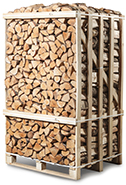To kiln dry or to air dry? What is the best for the Earth?
We all know that kiln dried logs are better for our health, help to reduce pollution, have better heat output and reduce maintenance costs of a stove and chimney. But did you know that a kiln drying process can be better for the environment than air drying? Keep reading and you will get your answer.
If you look on the right side of the first image, you will see an air dried logs manufacturing process from 100m3 raw wood to energy production equivalent to 201920kWh. On the left side you will see the Vli Timber kiln drying process producing 226970kWh, which is 12% more renewable energy in comparison with air dried production. HOW? Let’s take it step by step.

On the right side, from 100m3 birch air dried production, you will lose around 5m3 in 12 months due to natural rotting while air drying and produce 7m3 of wood waste during the splitting process, leaving 88m3 of air dried logs.
On the left, a kiln dried process uses sawdust and wood waste for heating boilers (7m3 of wood), and electricity (equivalent to 0.17m2 of wood) to operate the kilns, and dry the logs within 45-60 hours. Meaning, the equivalent of 7.17m3 of wood is used efficiently in production, making Vli Timber a zero-waste manufacturer.
After splitting 100m3 of wood and air drying process you are left with 7m3 of wet non-efficient wood waste and 88 m3 of logs that remain 25% of moisture, which have less heat output. Air dried logs and wood waste create 201920kWh of energy. After splitting 100m3 of wood and kiln drying at Vli Timber you are left with 95m3 of 15% moisture logs that are ready to burn, producing more heat and creating up to 12% more renewable energy – 226970kWh.
The numbers speak for itself, it is obvious that the Vli Timber kiln drying process creates more energy compared to any air drying process, however, how about the CO2 emission? Isn’t it the air drying creates less CO2 than the kiln drying technique? You will probably be surprised that Vli Timber kiln drying and any air drying process creates the same amount of CO2. Furthermore, if we leave the same 100m3 of wood to rot in the forest, it creates the same amount of CO2 as making kiln dried logs and burning them in the stove in total. The reason is that wood while rotting emits the same amount of CO2 as burning.
To reach the environmental benefits mentioned above Vli Timber completely renewed their wood drying process in 2020. Moreover, companies’ environmental goals do not end here as continuous improvement is a part of Vli Timber culture.
Get in touch with Vli Timber for global production of its best products straight to your door.









